+ データを開く
データを開く
- 基本情報
基本情報
| 登録情報 | データベース: PDB / ID: 6gdg | |||||||||
|---|---|---|---|---|---|---|---|---|---|---|
| タイトル | Cryo-EM structure of the adenosine A2A receptor bound to a miniGs heterotrimer | |||||||||
 要素 要素 |
| |||||||||
 キーワード キーワード | MEMBRANE PROTEIN / G-protein coupled receptor / adenosine / GPCR / A2A receptor | |||||||||
| 機能・相同性 |  機能・相同性情報 機能・相同性情報positive regulation of acetylcholine secretion, neurotransmission / regulation of norepinephrine secretion / negative regulation of alpha-beta T cell activation / positive regulation of circadian sleep/wake cycle, sleep / Adenosine P1 receptors / G protein-coupled adenosine receptor activity / response to purine-containing compound / G protein-coupled adenosine receptor signaling pathway / NGF-independant TRKA activation / sensory perception ...positive regulation of acetylcholine secretion, neurotransmission / regulation of norepinephrine secretion / negative regulation of alpha-beta T cell activation / positive regulation of circadian sleep/wake cycle, sleep / Adenosine P1 receptors / G protein-coupled adenosine receptor activity / response to purine-containing compound / G protein-coupled adenosine receptor signaling pathway / NGF-independant TRKA activation / sensory perception / Surfactant metabolism / positive regulation of urine volume / synaptic transmission, dopaminergic / type 5 metabotropic glutamate receptor binding / negative regulation of vascular permeability / positive regulation of glutamate secretion / synaptic transmission, cholinergic / intermediate filament / presynaptic active zone / response to caffeine / blood circulation / eating behavior / inhibitory postsynaptic potential / DNA polymerase processivity factor activity / alpha-actinin binding / regulation of calcium ion transport / neuron projection morphogenesis / protein-disulfide reductase activity / asymmetric synapse / PKA activation in glucagon signalling / membrane depolarization / developmental growth / axolemma / hair follicle placode formation / phagocytosis / D1 dopamine receptor binding / positive regulation of synaptic transmission, glutamatergic / prepulse inhibition / cellular defense response / intracellular transport / vascular endothelial cell response to laminar fluid shear stress / renal water homeostasis / activation of adenylate cyclase activity / Hedgehog 'off' state / adenylate cyclase-activating adrenergic receptor signaling pathway / regulation of mitochondrial membrane potential / presynaptic modulation of chemical synaptic transmission / cellular response to glucagon stimulus / astrocyte activation / regulation of insulin secretion / cell redox homeostasis / response to amphetamine / adenylate cyclase activator activity / central nervous system development / positive regulation of apoptotic signaling pathway / positive regulation of long-term synaptic potentiation / trans-Golgi network membrane / excitatory postsynaptic potential / positive regulation of protein secretion / positive regulation of synaptic transmission, GABAergic / synaptic transmission, glutamatergic / locomotory behavior / apoptotic signaling pathway / negative regulation of inflammatory response to antigenic stimulus / bone development / adenylate cyclase-modulating G protein-coupled receptor signaling pathway / negative regulation of inflammatory response / platelet aggregation / G-protein beta/gamma-subunit complex binding / cognition / Olfactory Signaling Pathway / vasodilation / Activation of the phototransduction cascade / G beta:gamma signalling through PLC beta / Presynaptic function of Kainate receptors / Thromboxane signalling through TP receptor / G protein-coupled acetylcholine receptor signaling pathway / G-protein activation / Activation of G protein gated Potassium channels / Inhibition of voltage gated Ca2+ channels via Gbeta/gamma subunits / adenylate cyclase-activating G protein-coupled receptor signaling pathway / Prostacyclin signalling through prostacyclin receptor / G beta:gamma signalling through CDC42 / Glucagon signaling in metabolic regulation / G beta:gamma signalling through BTK / Synthesis, secretion, and inactivation of Glucagon-like Peptide-1 (GLP-1) / ADP signalling through P2Y purinoceptor 12 / photoreceptor disc membrane / Sensory perception of sweet, bitter, and umami (glutamate) taste / blood coagulation / Glucagon-type ligand receptors / Adrenaline,noradrenaline inhibits insulin secretion / Vasopressin regulates renal water homeostasis via Aquaporins / Glucagon-like Peptide-1 (GLP1) regulates insulin secretion / G alpha (z) signalling events / ADP signalling through P2Y purinoceptor 1 / cellular response to catecholamine stimulus / ADORA2B mediated anti-inflammatory cytokines production / G beta:gamma signalling through PI3Kgamma / sensory perception of smell 類似検索 - 分子機能 | |||||||||
| 生物種 |   Homo sapiens (ヒト) Homo sapiens (ヒト) | |||||||||
| 手法 | 電子顕微鏡法 / 単粒子再構成法 / クライオ電子顕微鏡法 / 解像度: 4.11 Å | |||||||||
 データ登録者 データ登録者 | Garcia-Nafria, J. / Lee, Y. | |||||||||
| 資金援助 |  英国, 2件 英国, 2件
| |||||||||
 引用 引用 |  ジャーナル: Elife / 年: 2018 ジャーナル: Elife / 年: 2018タイトル: Cryo-EM structure of the adenosine A receptor coupled to an engineered heterotrimeric G protein. 著者: Javier García-Nafría / Yang Lee / Xiaochen Bai / Byron Carpenter / Christopher G Tate /  要旨: The adenosine A receptor (AR) is a prototypical G protein-coupled receptor (GPCR) that couples to the heterotrimeric G protein G. Here, we determine the structure by electron cryo-microscopy (cryo-EM) ...The adenosine A receptor (AR) is a prototypical G protein-coupled receptor (GPCR) that couples to the heterotrimeric G protein G. Here, we determine the structure by electron cryo-microscopy (cryo-EM) of AR at pH 7.5 bound to the small molecule agonist NECA and coupled to an engineered heterotrimeric G protein, which contains mini-G, the βγ subunits and nanobody Nb35. Most regions of the complex have a resolution of ~3.8 Å or better. Comparison with the 3.4 Å resolution crystal structure shows that the receptor and mini-G are virtually identical and that the density of the side chains and ligand are of comparable quality. However, the cryo-EM density map also indicates regions that are flexible in comparison to the crystal structures, which unexpectedly includes regions in the ligand binding pocket. In addition, an interaction between intracellular loop 1 of the receptor and the β subunit of the G protein was observed. | |||||||||
| 履歴 |
|
- 構造の表示
構造の表示
| ムービー |
 ムービービューア ムービービューア |
|---|---|
| 構造ビューア | 分子:  Molmil Molmil Jmol/JSmol Jmol/JSmol |
- ダウンロードとリンク
ダウンロードとリンク
- ダウンロード
ダウンロード
| PDBx/mmCIF形式 |  6gdg.cif.gz 6gdg.cif.gz | 211.1 KB | 表示 |  PDBx/mmCIF形式 PDBx/mmCIF形式 |
|---|---|---|---|---|
| PDB形式 |  pdb6gdg.ent.gz pdb6gdg.ent.gz | 155 KB | 表示 |  PDB形式 PDB形式 |
| PDBx/mmJSON形式 |  6gdg.json.gz 6gdg.json.gz | ツリー表示 |  PDBx/mmJSON形式 PDBx/mmJSON形式 | |
| その他 |  その他のダウンロード その他のダウンロード |
-検証レポート
| 文書・要旨 |  6gdg_validation.pdf.gz 6gdg_validation.pdf.gz | 845.3 KB | 表示 |  wwPDB検証レポート wwPDB検証レポート |
|---|---|---|---|---|
| 文書・詳細版 |  6gdg_full_validation.pdf.gz 6gdg_full_validation.pdf.gz | 846.2 KB | 表示 | |
| XML形式データ |  6gdg_validation.xml.gz 6gdg_validation.xml.gz | 29.7 KB | 表示 | |
| CIF形式データ |  6gdg_validation.cif.gz 6gdg_validation.cif.gz | 45.3 KB | 表示 | |
| アーカイブディレクトリ |  https://data.pdbj.org/pub/pdb/validation_reports/gd/6gdg https://data.pdbj.org/pub/pdb/validation_reports/gd/6gdg ftp://data.pdbj.org/pub/pdb/validation_reports/gd/6gdg ftp://data.pdbj.org/pub/pdb/validation_reports/gd/6gdg | HTTPS FTP |
-関連構造データ
| 関連構造データ |  4390MC M: このデータのモデリングに利用したマップデータ C: 同じ文献を引用 ( |
|---|---|
| 類似構造データ | |
| 電子顕微鏡画像生データ |  EMPIAR-10309 (タイトル: Cryo-EM structure of the adenosine A2A receptor coupled to an engineered heterotrimeric G protein EMPIAR-10309 (タイトル: Cryo-EM structure of the adenosine A2A receptor coupled to an engineered heterotrimeric G proteinData size: 1.1 TB Data #1: Unaligned multi-frame micrographs [micrographs - multiframe] Data #2: Micelle subtracted particles [picked particles - multiframe - processed] Data #3: Particles before subtraction [picked particles - multiframe - processed]) |
- リンク
リンク
- 集合体
集合体
| 登録構造単位 | 
|
|---|---|
| 1 |
|
- 要素
要素
-Guanine nucleotide-binding protein ... , 3種, 3分子 BCD
| #2: タンパク質 | 分子量: 37285.734 Da / 分子数: 1 / 由来タイプ: 組換発現 / 由来: (組換発現)  Homo sapiens (ヒト) / 遺伝子: GNB1 / 発現宿主: Homo sapiens (ヒト) / 遺伝子: GNB1 / 発現宿主:  Trichoplusia ni (イラクサキンウワバ) / 参照: UniProt: P62873 Trichoplusia ni (イラクサキンウワバ) / 参照: UniProt: P62873 |
|---|---|
| #3: タンパク質 | 分子量: 7845.078 Da / 分子数: 1 / 由来タイプ: 組換発現 / 由来: (組換発現)  Homo sapiens (ヒト) / 遺伝子: GNG2 / 発現宿主: Homo sapiens (ヒト) / 遺伝子: GNG2 / 発現宿主:  Trichoplusia ni (イラクサキンウワバ) / 参照: UniProt: P59768 Trichoplusia ni (イラクサキンウワバ) / 参照: UniProt: P59768 |
| #4: タンパク質 | 分子量: 28907.684 Da / 分子数: 1 / 由来タイプ: 組換発現 / 由来: (組換発現)  Homo sapiens (ヒト) / 遺伝子: GNAS, GNAS1, GSP / 発現宿主: Homo sapiens (ヒト) / 遺伝子: GNAS, GNAS1, GSP / 発現宿主:  Trichoplusia ni (イラクサキンウワバ) / 参照: UniProt: P63092 Trichoplusia ni (イラクサキンウワバ) / 参照: UniProt: P63092 |
-タンパク質 / 抗体 / 非ポリマー , 3種, 3分子 AE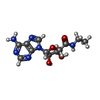

| #1: タンパク質 | 分子量: 52909.785 Da / 分子数: 1 / 断片: UNP residues 37-144,UNP residues 8-316 / 由来タイプ: 組換発現 由来: (組換発現)   Homo sapiens (ヒト) Homo sapiens (ヒト)遺伝子: trxA, ADORA2A, ADORA2 / 発現宿主:  Trichoplusia ni (イラクサキンウワバ) Trichoplusia ni (イラクサキンウワバ)参照: UniProt: Q14F07, UniProt: P29274, UniProt: P0AA25*PLUS |
|---|---|
| #5: 抗体 | 分子量: 16926.076 Da / 分子数: 1 / 由来タイプ: 組換発現 / 由来: (組換発現)   |
| #6: 化合物 | ChemComp-NEC / |
-詳細
| Has protein modification | Y |
|---|
-実験情報
-実験
| 実験 | 手法: 電子顕微鏡法 |
|---|---|
| EM実験 | 試料の集合状態: PARTICLE / 3次元再構成法: 単粒子再構成法 |
- 試料調製
試料調製
| 構成要素 |
| ||||||||||||||||||||||||||||||
|---|---|---|---|---|---|---|---|---|---|---|---|---|---|---|---|---|---|---|---|---|---|---|---|---|---|---|---|---|---|---|---|
| 分子量 | 値: 0.137 MDa / 実験値: NO | ||||||||||||||||||||||||||||||
| 由来(天然) |
| ||||||||||||||||||||||||||||||
| 由来(組換発現) |
| ||||||||||||||||||||||||||||||
| 緩衝液 | pH: 7.5 | ||||||||||||||||||||||||||||||
| 試料 | 濃度: 1 mg/ml / 包埋: NO / シャドウイング: NO / 染色: NO / 凍結: YES | ||||||||||||||||||||||||||||||
| 試料支持 | グリッドの材料: GOLD / グリッドのサイズ: 300 divisions/in. / グリッドのタイプ: Quantifoil R1.2/1.3 | ||||||||||||||||||||||||||||||
| 急速凍結 | 装置: FEI VITROBOT MARK IV / 凍結剤: ETHANE / 湿度: 100 % / 凍結前の試料温度: 277.15 K |
- 電子顕微鏡撮影
電子顕微鏡撮影
| 実験機器 |  モデル: Titan Krios / 画像提供: FEI Company |
|---|---|
| 顕微鏡 | モデル: FEI TITAN KRIOS |
| 電子銃 | 電子線源:  FIELD EMISSION GUN / 加速電圧: 300 kV / 照射モード: FLOOD BEAM FIELD EMISSION GUN / 加速電圧: 300 kV / 照射モード: FLOOD BEAM |
| 電子レンズ | モード: BRIGHT FIELD / Cs: 2.7 mm / C2レンズ絞り径: 50 µm / アライメント法: COMA FREE |
| 試料ホルダ | 凍結剤: NITROGEN 試料ホルダーモデル: FEI TITAN KRIOS AUTOGRID HOLDER |
| 撮影 | 平均露光時間: 60 sec. / 電子線照射量: 30 e/Å2 / 検出モード: COUNTING フィルム・検出器のモデル: FEI FALCON III (4k x 4k) |
- 解析
解析
| EMソフトウェア |
| ||||||||||||||||||||||||||||||||||||||||
|---|---|---|---|---|---|---|---|---|---|---|---|---|---|---|---|---|---|---|---|---|---|---|---|---|---|---|---|---|---|---|---|---|---|---|---|---|---|---|---|---|---|
| CTF補正 | タイプ: PHASE FLIPPING AND AMPLITUDE CORRECTION | ||||||||||||||||||||||||||||||||||||||||
| 対称性 | 点対称性: C1 (非対称) | ||||||||||||||||||||||||||||||||||||||||
| 3次元再構成 | 解像度: 4.11 Å / 解像度の算出法: FSC 0.143 CUT-OFF / 粒子像の数: 128002 / アルゴリズム: FOURIER SPACE / 対称性のタイプ: POINT | ||||||||||||||||||||||||||||||||||||||||
| 原子モデル構築 | プロトコル: FLEXIBLE FIT / 空間: RECIPROCAL |
 ムービー
ムービー コントローラー
コントローラー



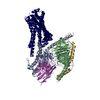
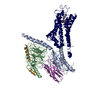
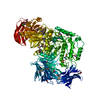
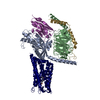
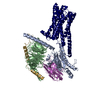

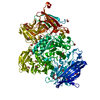



 PDBj
PDBj



























